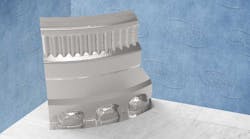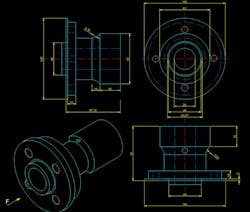Outsourcing CAD Engineering Delivers Savings, Flexibility
At a Glance:
- While the material handling and logistics industry was at the forefront of the inhouse versus outsourcing decisions in 2020, manufacturing and engineering operations have been wrestling with this conundrum for years.
- Outsourcing CAD work enables manufacturers to better meet ever-changing demand, reduce costs and increase flexibility.
- The risks and benefits of outsourcing some or all of its CAD work.
Over the last year, few industries have witnessed demand skyrocket like material handling and logistics. The pandemic forced a shift in shopping habits and challenged an already-thriving industry to satisfy the sudden boom in demand from online shopping and home delivery. Amazon alone hired more than 100,000 new workers in 2020 to beef up its operations. The typical ebb and flow quickly turned into flow and even more flow.
Companies that design and service the backbone of these operations—namely warehousing and distribution centers—struggled with the decision on whether to hire more CAD engineers or outsource the surplus work. For some, the option to contract out has proven to deliver increased savings and flexibility, while ensuring their workforce is made up of cutting-edge designers who are easy to train and manage.
“We are slammed,” explains Chris Perry, engineering manager for Bastian Solutions’ conveyor division. Bastian Solutions, a Toyota Advanced Logistics company specializes in providing some of the most complex material handling services throughout the world.
“We’ve got an engineering team that’s often working at 110% capacity,” Perry adds. “So, my challenge was to figure out what to do when two huge projects get thrown on top of that. We just felt that outsourcing the CAD modeling and drafting would give us greater flexibility and take the pressure off our internal team.”
While the material handling and logistics industry was at the forefront of the inhouse versus outsourcing decisions in 2020, a number of manufacturing and engineering operations have been wrestling with this conundrum for years.
Conveying the Message
Bastian Solutions is well known for, among other things, its conveyor systems which can reach several miles long, handle unique dimensions and carry a wide variety of loads. Every project is tailor-made by a system designer to optimize throughput at each particular facility. The part requirements are then fed to the engineering team, which Perry manages.
“These conveyor systems are always customized,” he says. “If the part for a configuration that gets ordered is not in our standard library, it has to be drawn up, modeled and added to the library.”
On top of that, Perry and his team are also working on internal product development design projects. Therefore, the topic of outsourcing or adding a full-time employee was often debated. “For budgetary planning reasons it just makes more sense to be able to flex our muscles using an external contractor rather than bringing on permanent headcount,” he says.
Last summer when warehousing and distribution centers were preparing for what wound up being a record-breaking holiday rush, Bastian Solutions decided that it made sense to outsource some of its CAD engineering work to ensure its inhouse design engineers would not be overworked.
Perry says it was a struggle to find a firm that could handle their internal process control and quality management systems while still being in or close to the company’s eastern time zone. “The benefit for me is being able to assign the contract engineer the routine work,” says Perry. “This frees up my internal team to tackle product development and continuous improvement projects.”
This type of “routine” work often includes simply creating a new SKU for a custom design. As an example, a conveyor roller must now be designed at a unique length. However, the routine work may also cross over into quality control issues, such as deviation analysis. This can include the scanning of manufactured parts, which are then turned into CAD files, to ensure they meet the original specs.
Currently, Bastian Solutions is seeing such great potential in its initial outsourcing to its CAD/CAM provider, that it is already considering flexing to a few more outsourced CAD technicians to add to the team.
There are some risks associated with outsourcing to an outside CAD provider, and it is critical to enlist the services of one that can address common areas of concern. A major one of these would be letting outside contractors into the network, which often leaves a backdoor for hackers.
The CAD engineering firm should also have extensive experience working with complicated and often unique product lifecycle management (PLM) and product data management (PDM) systems, which can take 40-80 hours of training to properly navigate. Furthermore, there should also be a gated system so that all work is properly vetted and approved before it goes live into a design.
Outsourcing CAD
Perry points out that while his team was mainly focused on flexibility, there are a number of reasons why a company could benefit from outsourcing some or all of its CAD work—the top reason being cost. A company outsourcing could save on a dedicated salary and benefits package, as well as by reducing the need for another suite of high-priced 3D CAD software. There are often additional savings with computer hardware and even office space.
Furthermore, staying on the leading edge of CAD technology can be time-consuming, and it is often more convenient for companies to be able to turn to well-trained specialists at a moment’s notice without going through the process of recruiting and hiring.
Scott Shuppert is CEO at CAD/CAM Services, a computer-aided design and engineering firm with expertise in 3D scanning, modeling and conversions.




